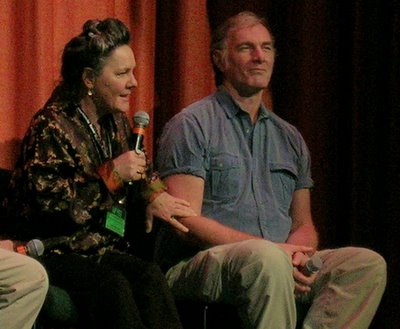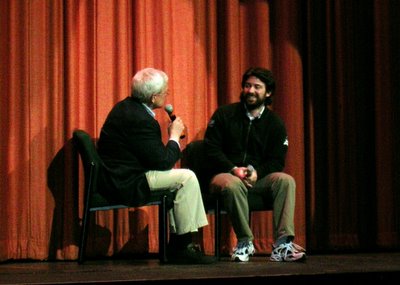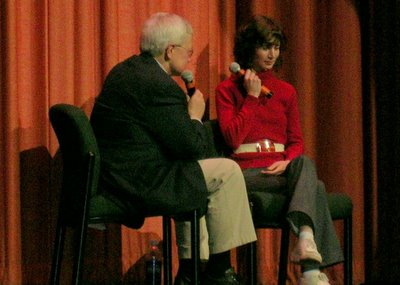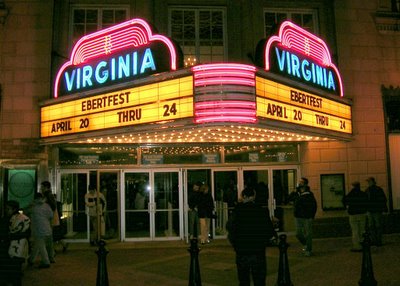
The University of Illinois (April 23, 2005/Mark Pfeiffer)
My first Overlooked Film Festival was in 2001, and it was as much of an endurance test as any I had in moviegoing. Four films a day every day, opening night and closing day excepted. It was not unusual for the day's final discussion to wrap around 1 a.m. Festival organizers have opened up the schedule this year so that it is possible to get something to eat from somewhere besides the concession stand or the vendor outside the Virginia and get to bed at a relatively sane hour.
Up to this point none of the days have been all that grueling. Or maybe I'm fest-tested, especially after doing consecutive days of five films at Cleveland in March. Whatever the case, day 4 at Roger Ebert's 7th Overlooked Film Festival is a more accommodating version of one of those time crunch days.

Roger Ebert and Jean Picker Firstenberg
But first! Another discussion! This time with Roger Ebert and Jean Picker Firstenberg, Director and Chief Executive Officer of the American Film Institute! And I didn't take notes! Again! But how about making up for it with enthusiastic non-reporting!

The Secret of Roan Inish producer Maggie Renzi and director John Sayles
It's tradition for Saturday to begin with a free children's matinee. John Sayles' THE SECRET OF ROAN INISH was selected for this slot, and while it might be a little more challenging than is typically expected of kids' fare, who says that's a bad thing? God knows there are plenty of emptyheaded movies targetd at children.
There's a legend in Fiona's (Jeni Courtney) family that long ago one of her ancestors married a Selkie, a half-woman, half-seal creature. The couple had children, which explains why the following generations bore dark-haired children drawn to the ocean.
Fiona has been sent to live with her grandparents, who reside across the water from the family's one-time home on the island of Roan Inish. She explores the island and finds some things that her family may find hard to believe.
Sayles' austere film emphasizes the power of storytelling, particularly those tales passed down through generations. Fiona takes her family's legend seriously, and why shouldn't she? Religious instruction and ways of understanding the world originate from this oral tradition. As Fiona, Courtney delivers a delightful performance.
I don't know about the kids, but this Irish family fable proved challenging for me, although on a sleep level rather than an intellectual one. So pardon my less than revelatory writing on THE SECRET OF ROAN INISH. It was inevitable that I'd struggle to stay awake at least once during the festival. This just happened to be the film during which I drifted in and out.

Ebert and Primer director Shane Carruth
I needed all of my senses about me for the next film, and even then I was bewildered. I don't really know where to begin with PRIMER, a great film that I didn't understood entirely. If ever there was a film for me to recommend to my brothers, all engineers, this is the one. Maybe they could cut through the dense, technically precise dialogue. Or maybe not. The characters talk quickly and overlap one another like people do in real life.
Four tech workers are trying to obtain venture capital for their invention. Similar to the humble origins of other tech companies, these guys are beginning in a garage and hoping to hit the jackpot. Eventually the project is taken over by Aaron (Shane Carruth, also the film's writer and director) and Abe (David Sullivan), two of the initial four. Their invention seems to be some kind of time machine, and of course Aaron and Abe have to try it out, even if they're not entirely sure what they've created or what it might do to them.
PRIMER is a puzzle movie to end all puzzle movies. I'm incapable of explaining the film and may not even have followed all of it, yet I don't think that it's critical to penetrate all of the tech-head jargon. Carruth knows these types of people and their relationships backwards and forwards, so even if what they're doing is mystifying, who they are isn't. So much modern sci-fi is about gadgets--and PRIMER has a nifty one at the center--but few demonstrate such insight for the characters.
It helps that Carruth's direction is superb. PRIMER is cut together well and flows so that everything you need to know is present even if it isn't all understandable. Carruth made PRIMER for reportedly $7000, but it doesn't look like it. The cool blue/green tint enhances the futuristic, cutting edge of tech world these characters inhabit. He has a strong sense of composition, with everything within the frame taking a diagram's structure. Carruth also inserts some sly visual jokes, in one instance panning over to show the solution that one character already knows is there. It's in keeping with the film's themes of doubles and prescience.
Ebertfest has a higher percentage of good films--of course, he'd say it's 100%--than practically any other festival one is likely to attend. That it's a curated festival has a lot to do with the fact that clunkers are rare occurrences. Nevertheless, we've found one in Vincent Ward's MAP OF THE HUMAN HEART. I was no fan of his WHAT DREAMS MAY COME, so perhaps I shouldn't be surprised.

Ebert with Map of the Human Heart director Vincent Ward and star Jason Scott Lee
Films like MAP OF THE HUMAN HEART either work for you or seem dippy. I'm definitely in the latter camp. Here we get one of those passionate romances about lovers kept apart, but there's enough syrup to make you want to gag.
In 1931 an Inuit boy, Avik, is brought from the Arctic to a foster home in Montréal. There he meets Albertine, a girl whose French and Indian heritage makes her something of an outsider at the school as well. They become fast friends. Ten years later in London, Avik and Albertine (Jason Scott Lee and Anne Parillaud) renew their love affair. Complicating matters is Walter Russell (Patrick Bergin), the cartographer who befriended a young Avik and was responsible for taking him to Canada. Walter and Anne are a couple when Avik encounters them, creating a love triangle that could destroy all of their prior relationships.
This is standard romantic melodrama stuff, and there's no doubt that the emotion is in the story. It isn't, however, in these dull, partially formed characters. Not helping matters is Parillaud's insufferable performance and the oh so precious sequences with the kids (played quite annoyingly by the child actors). That cloying quality extends to a completely misconceived section in which Avik is busy screwing around taking aerial photos to send a loving message to Albertine when he should be doing his critical job during World War II. But it's all for Love, you say. True, but will anyone care if England's in flames because they're preoccupied with their love games?
Released in 1993, MAP OF THE HUMAN HEART feels like the sort of Oscar-grubbing fare Miramax was accused of releasing. Fair enough. The Weinsteins' company distributed Ward's film.
MAP OF THE HUMAN HEART isn't a total wash, though. There are two visually captivating love scenes, one atop a hot air balloon and another at the peak of the Royal Albert Hall. The shot of the entwined lovers on the balloon takes away one's breath as it reveals them in midair while the balloon is tethered to the ground.

Ebert and Me and You and Everyone We Know director Miranda July
The day's last film was Ebert's Sundance fave ME AND YOU AND EVERYONE WE KNOW, Miranda July’s comic musings on the search for love. July plays Christine, a sensitive elder cab driver who finds an outlet in performance art. John Hawkes is Richard, a lonely shoe salesman coping with a recent divorce and trying to put on a brave face for his two kids. Christine and Richard’s awkward flirtation is the main story, but ME AND YOU AND EVERYONE WE KNOW also touches upon a few other characters’ tentative attempts to make a connection.
If Todd Solondz were a humanist, he might make something like performance artist July's winning debut feature film. Instead of observing human foibles and determining that people are diseased creatures, she finds something affirming and hopeful. Dressed in cheerful pastels, ME AND YOU AND EVERYONE WE KNOW is a comic look at how people keep themselves apart, remain confused about sex and love, and desperately want human contact but are afraid or think themselves unworthy of it. The film is neatly summarized in a scene in which Christine writes “me” on her left shoe and “you” on her right shoe. She then videotapes the feet hesitantly approaching and retreating from each other. July displays an excellent visual sense, such as buttonhook transitions from the moon to a mirror’s reflected beam and a tapping penny to the moving sun.
She expertly straddles the line of edgy humor without taking it someplace really twisted. July gently skewers the art world and takes provocative jabs at sexual and emotional hang-ups. Initially ME AND YOU AND EVERYONE WE KNOW’S sketch-like construction may seem facile and too precious, but the slowly emerging through line leads to an emotionally affecting resolution. Similarly, Michael Andrews’ electronic score, akin to the music of The Postal Service and other laptop pop bands, sounds chilly before revealing the deeply rooted passion. Ultimately July is interested in exploring the barriers and freedom offered through technology. The digital age affords the ability to be anyone, witnessed most humorously in the film’s chat room “sex” scene, but July questions if it is worth false or absent intimacy.
During the post-film discussion July didn't seem all that different from her on-screen persona, but far be it from me to guess in which, if either, she was playing a role.

No comments:
Post a Comment